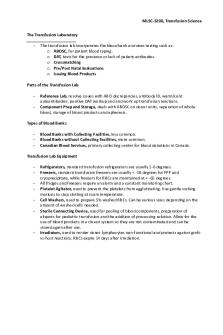K15 - intro to kinesiology PDF

| Title | K15 - intro to kinesiology |
|---|---|
| Course | Intro to Kinesiology |
| Institution | University of Wisconsin-Madison |
| Pages | 3 |
| File Size | 42.1 KB |
| File Type | |
| Total Downloads | 47 |
| Total Views | 134 |
Summary
intro to kinesiology...
Description
C What does doing a leg curl produce? A) muscle B) force C) torque D) strength B The guiding principles and concepts of biomechanics come from which of the following subdisciplines? A) biomechanical measurements, biological engineering, chemistry, and biology B) mechanical physics, mechanical and biological engineering, and biology C) mechanical physics, biology, biomechanical measurement, and content analysis D) exercise physiology, mechanical physics, biology, and mechanical biology A What is the recommended amount of physical activity for improving cardiorespiratory endurance? A) 20 to 60 min of activity at 70% to 90% of maximal heart rate, three to five days per week B) 20 to 60 min of activity at 50% to 80% of maximal heart rate, one or two days per week C) 10 to 15 min of activity at 80% to 90% of maximal heart rate, one or two days per week D) 10 to 15 min of activity at 70% to 90% of maximal heart rate, three to five days per week A When body temperature rises during physical activity, which thermoregulatory response is stimulated? A) sweating B) all of these C) vasoconstriction of skin blood vessels D) shivering A What is (are) the goal(s) of exercise physiology? A) all of the above B) to understand human exercise C) to improve physical fitness D) to improve sport performance B Treadmills, cycles, and swimming flumes are used to estimate VO2max. What are these devices called? A) exercise equipment B) ergometers C) tissot spirometers
D) cardiac rehab devices TRUE During moderate and heavy exercise, heart rate increases linearly with an increase in oxygen uptake. A) True B) False C What is the ability to exercise at moderate to heavy intensities for prolonged periods? A) endurance and rest period B) fatigue or cardiac output C) aerobic or cardiorespiratory endurance D) running and then jogging C The Surgeon General's Report on Physical Activity and Health was issued in what year? A) 1990 B) 1986 C) 1996 D) 2001 TRUE In addition to a degree in exercise physiology, a credential for a fitness professional is a certification from an organization such as ACSM. A) True B) False C _____ increases rapidly at the onset of physical activity and also increases as a function of exercise intensity. A) Respiration B) Perspiration C) Ventilation D) Dilation TRUE Exercise physiology, biomechanics, sport history, and motor learning are examples of the subdisciplines of kinesiology. A) True B) False B What nutrient makes up 55% to 60% of the human body?
A) fat B) water C) carbohydrate D) protein TRUE The principle of overload means that the training intensity must be greater than normally experienced. A) True B) False D This kinesiologist was one of the first to contribute to the field of exercise physiology with his Nobel Prize-winning work on metabolism. A) Thomas Cureton B) D.B. Dill C) Kenneth Cooper D) A.V. Hill C An exercise physiologist is conducting research on the aerobic energy system. What might be the dependent variable used in her training program? A) training intensity B) amount of energy expended in a half-mile run C) VO2max D) number of days per week of exercise training D When an athlete is competing in a high-intensity physical activity, muscle glycogen is the main source of energy. Where does the body store it and where does it come from? A) tendons; protein B) muscles; lipid C) skeletal muscles; protein D) skeletal muscles; carbohydrate C What type of muscle fiber uses anaerobic energy systems almost exclusively? A) all of these B) fast oxidative glycolytic fibers C) fast glycolytic fibers D) slow-twitch fibers...
Similar Free PDFs

K15 - intro to kinesiology
- 3 Pages

K14 - intro to kinesiology
- 3 Pages

K13 - intro to kinesiology
- 4 Pages

K3 - intro to kinesiology
- 3 Pages

K2 - intro to kinesiology
- 3 Pages

K11 - intro to kinesiology
- 3 Pages

Intro to textiles
- 8 Pages

Intro to Med Term
- 41 Pages

Intro to Tinker CAD
- 3 Pages

Intro to Oscilloscopes
- 8 Pages

Intro to Sociology
- 34 Pages

Intro to Transfusion Science
- 3 Pages

Intro to computational physics
- 3 Pages

Intro to marketing syllabus
- 19 Pages
Popular Institutions
- Tinajero National High School - Annex
- Politeknik Caltex Riau
- Yokohama City University
- SGT University
- University of Al-Qadisiyah
- Divine Word College of Vigan
- Techniek College Rotterdam
- Universidade de Santiago
- Universiti Teknologi MARA Cawangan Johor Kampus Pasir Gudang
- Poltekkes Kemenkes Yogyakarta
- Baguio City National High School
- Colegio san marcos
- preparatoria uno
- Centro de Bachillerato Tecnológico Industrial y de Servicios No. 107
- Dalian Maritime University
- Quang Trung Secondary School
- Colegio Tecnológico en Informática
- Corporación Regional de Educación Superior
- Grupo CEDVA
- Dar Al Uloom University
- Centro de Estudios Preuniversitarios de la Universidad Nacional de Ingeniería
- 上智大学
- Aakash International School, Nuna Majara
- San Felipe Neri Catholic School
- Kang Chiao International School - New Taipei City
- Misamis Occidental National High School
- Institución Educativa Escuela Normal Juan Ladrilleros
- Kolehiyo ng Pantukan
- Batanes State College
- Instituto Continental
- Sekolah Menengah Kejuruan Kesehatan Kaltara (Tarakan)
- Colegio de La Inmaculada Concepcion - Cebu

